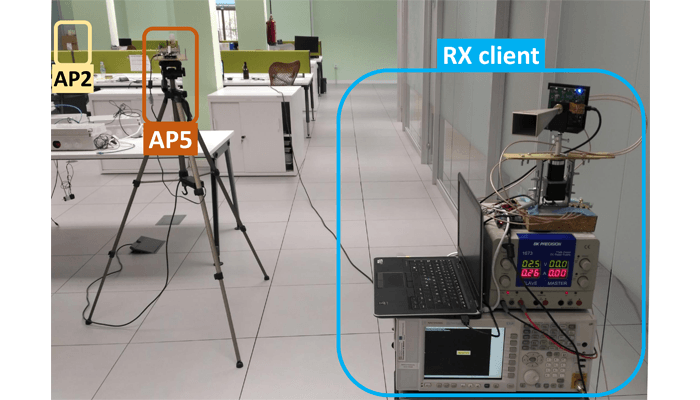Jun 14 2019
The radio frequency spectrum, the foundation for wireless telecommunications, is a finite resource that must be handled efficiently to meet the requirements posed by the exponential development in wireless internet access.
 Image credit: IMDEA
Image credit: IMDEA
Scientists at IMDEA Networks have created a new communications architecture for potential ultrafast wireless networks that assure to attain data rates that were earlier possible only with optical fiber.
Modern wireless communication already works close to its maximum technical capacity and the only feasible option to meet the rising demands to multiply the amount of data passed on is increasing the communication bandwidth being used. This is what was performed by the Wireless Networking Group at IMDEA Networks, headed by Computer Scientist and Research Professor Dr Joerg Widmer, in the framework of the recently concluded SEARCHLIGHT project.
Dr Widmer, who received a 1.7 million Euro ERC Consolidator Grant to conduct this study, has created an omnipresent, flexible, robust, cost-effective, and interoperable wireless network technology that functions in high-frequency bands that were not used before, for example, the unlicensed 60 GHz band.
The contributions of this project will gain popularity with the increase in the congestion rate of lower frequency networks and as the spectrum becomes a limited resource for telecommunication operators. Although millimeter-wave consumer electronics is yet to be extensively organized, technology leaders are already experimenting widely with millimeter-wave technology to obtain data rates that were earlier achieved only with optical fiber.
Facebook started the Terragraph project that employs a mesh of reconfigurable millimeter-wave links to offer reliable, high-speed Internet access in urban and suburban areas. It earlier experimented with networks of solar-powered drones with millimeter-wave backhaul and interconnection links to offer connectivity in regions with limited infrastructure. The Loon project by Alphabet (Google) employs high-altitude balloons with millimeter-wave links for the same reason.
Millimeter-wave technology also has very attractive properties for large-scale networks of small satellites to offer global connectivity, such as the projected Starlink network of SpaceX and PointView Tech (Facebook), and is most likely to be employed in networks of such types. With the increasing capacity and density of such types of networks, the scalability outcomes of this ERC project will be of high practical significance.
The ground breaking protocols and algorithms we have developed provide key elements for the scalability of future wireless networks. In analogy to the evolution of wired Ethernet from a shared medium to a fully switched network, we envision that future wireless networks will consist of many highly directional LOS (line-of-sight) channels for communication between access points (APs) and end devices.
Dr Joerg Widmer, Computer Scientist and Research Professor, IMDEA Networks
Therefore, the architecture of potential millimeter-wave networks will be typified by being highly scalable and ultra-dense.
“In order to deal with the extremely dynamic radio environments where channels may appear and disappear over very short time intervals, SEARCHLIGHT uses angle information to rapidly align the directional millimeter-wave antennas,” explains Dr Widmer. “The architecture integrates a location system and learns a map of the radio environment, which allows to rapidly select the most suitable access point and antenna beam pattern and allocate radio resource using predicted location as context information. Access points are deployed ubiquitously to provide continuous connectivity even in face of mobility and blockage and the project developed very low overhead network management mechanisms to cope with the high device density.”
Dr Widmer, has recently been awarded a H2020 Marie Sklodowska-Curie Innovative Training Network grant on “Millimeter-wave Networking and Sensing for Beyond 5G,” and within this project, his team will follow up on the potential work that was commenced during the ERC grant.
The work of the prominent ERC grant also resulted in a partnership project funded by Huawei on millimeter-wave and low-frequency channel correlation and a sub-contracted project on a “Millimeter-wave SDR-based Open Experimentation Platform” within the context of the H2020 project “Orchestration and Reconfiguration Control Architecture” (ORCA), to expand a FPGA-based platform to less powerful hardware and allow remote access and experimentation for teaching and research.